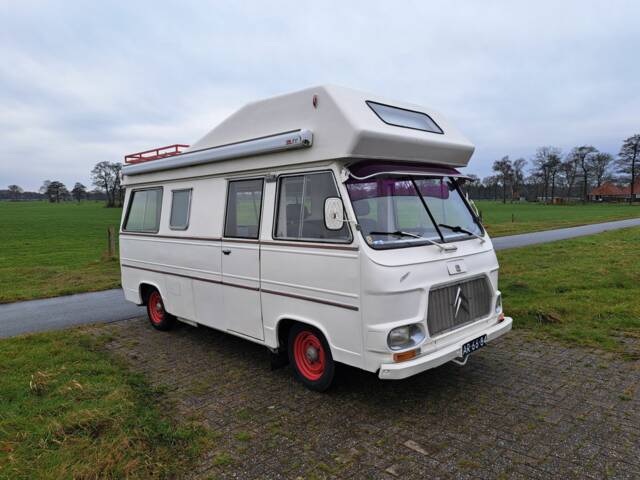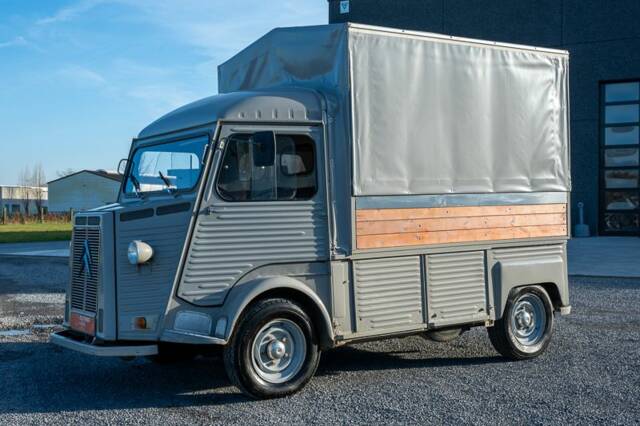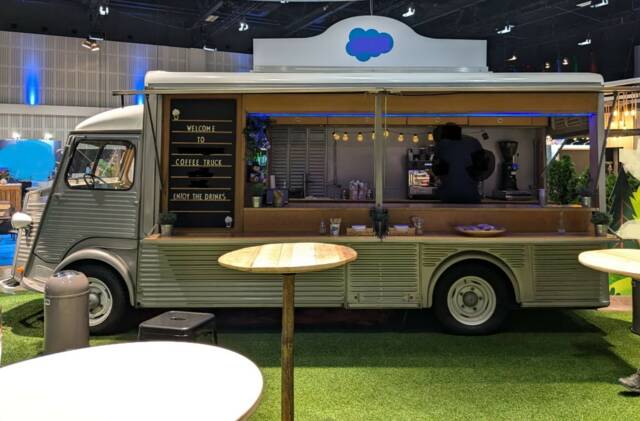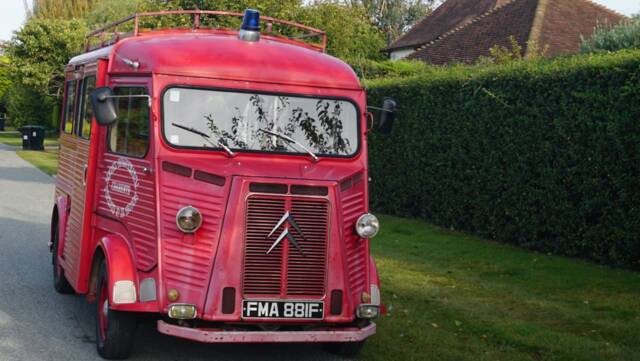Citroën Type H Classic Cars for Sale
The Citroën Type H, with its corrugated steel bodywork and unmistakably French silhouette, defined European light commercial vehicles from 1947 to 1981. Purpose-built for versatility, it has served as everything from bakery van to mobile café, police wagon and ambulance, and remains an unmissable classic for conversions and collectors alike.
Resultados de la búsqueda

1972 | Citroën HY
Citroën HY Currus CH14 | 1972 | Route 66 Auctions - For sale by auction. Estimate 14500 EUR

1972 | Citroën HY
Citroën HZ (1972)

1969 | Citroën HY
1969 Citroen HY '69

1977 | Citroën HY
Citroën HY 1600 Pick Up truck.1977. M0445
Citroën Type H listing references from Classic Trader
Below you will find listings related to your search that are no longer available on Classic Trader. Use this information to gain insight into availability, value trends, and current pricing for a "Citroën Type H" to make a more informed purchasing decision.

1957 | Citroën HY
1957 Citroen HY

1959 | Citroën HY
1959 Citroen HY '59

1959 | Citroën HY
1959 Citroen HY '59
1958 | Citroën HY
Baujahr 1958 und dennoch fast wie neu!

1982 | Citroën HY
1982 Citroen HY '82

1963 | Citroën HY
HY Benziner Foodtruck lang & hoch mit Servolenkung

1967 | Citroën HY
French fire tender first registered in France 14. 11. 1967 for French fire service.

1979 | Citroën HY
Citroën - HY - 1979

1969 | Citroën HY
Citroën-HY Camper

1957 | Citroën HY
Pick-up
History of the Citroën Type H
Developed in the late 1940s, the Citroën Type H responded to the urgent postwar need for durable, affordable, and flexible commercial vehicles. Succeeding the Citroën TUB and Type 32, the Type H debuted at the 1947 Paris Motor Show, predating the 2CV by a year. Production ran until 1981, with over 473,000 examples assembled in France and Belgium. Its advanced unibody architecture utilised corrugated steel for both strength and economy—a concept adapted from aircraft engineering, notably the Junkers Ju 52. The H-type quickly became synonymous with French commerce, seen everywhere in roles ranging from grocer’s runabout to municipal emergency van. The combination of a capacious modular interior and nimble front-wheel drive layout meant the Type H answered the needs of urban traders, rural artisans, and national services alike.
Model Series Overview
Initial models bore the simple Type H name, but expanded into a series: HX (lighter payloads), HW (heavy, extra room), HZ (higher payloads), and the universally popular HY, available from 1958 with payloads up to 1600kg. Assignments ranged from basic panel van to ambulance (with raised and lengthened roofs), catering vehicles, and promotional displays. Although produced mainly for left-hand drive markets with the bulk of sales in France, Belgium, and the Netherlands, the platform never received an official right-hand-drive version for Britain. The drivetrain and many components shared heritage with the Traction Avant and later the DS, making mechanical upkeep more straightforward for specialists enthused by Citroën's modular engineering.
Features and Market Data
The Type H stands out for its signature corrugated panels, advanced (for its time) engineering, and unmatched adaptability. Its recognition factor makes it especially valued as a mobile business platform even today. The comprehensive range of factory and bespoke conversions highlights its modularity: standard rear wing doors, options for side hatches or sliding doors, variable roof heights (up to 2.15m), and interior adaptability for food trucks, mobile shops, or campers. All told, no other Citroën commercial from the era matches the Type H for breadth of roles or global recognition.
Technical Data
Special Editions and Collector Variants
No explicit limited editions were marketed, but some variants have achieved collector distinction: high-roof ambulances, period-correct food trucks, original promotional vehicles, and meticulously restored original configurations. The HY, in particular, introduced in 1958, is widely sought after due to its increased load capacity and enduring popularity among professionals. Well-preserved or expertly restored Type H vans have achieved notable results at auction, with top sales such as a 1965 Type H reaching $77,000 in 2022.
Weak Spots and Common Issues
Notable for their mechanical simplicity, Type H vans are nevertheless vulnerable to time and use. Safety features—virtually nonexistent by modern standards—were minimal, lacking seatbelts and airbags. Electrical systems, especially on aging or poorly restored examples, are a frequent source of faults, with old wiring and fragile connectors needing comprehensive attention. Bodywork can suffer corrosion, especially around the wheel arches, door bottoms, and floor panels where moisture accumulates in the corrugated recesses. Regular inspection and rust-preventive measures are essential. Most mechanical parts (engine, gearbox, brakes) share compatibility with period Citroëns, ensuring that, for the well-prepared, keeping a Type H on the road is straightforward.
Engine, Transmission & On-Road Behaviour
Citroën’s front-drive layout lent the Type H surprising grip and usable performance for a commercial of its day. Suspension was independent at the front and, together with a robust hydraulic brake system and (in later years) power steering, provided a composed—if utilitarian—driving experience. Hydropneumatic suspension occasionally featured on special builds, especially ambulances, granting exceptional ride comfort on poor roads. Maximum power spanned from 36 hp on early 1.9 petrol engines to 68 hp on 2.0 versions, with diesel variants popular for their economy. The H-Type could approach 100 km/h (and up to 118 km/h with the largest engines); handling was predictable and ride surprisingly smooth thanks to Citroën’s focus on suspension innovation. - HY 1.9 Diesel (noted for torque and reliability in commercial settings)
- High-roof and extra-long conversions (sought after for modern food truck and camper applications)
- Early H versions with original interior (collector interest)
- Later 2.0 petrol models (best drivability and highest top speed)
Design, Interior & Accessories
Flamboyantly functional, the Type H’s corrugated panels were inspired by aircraft construction, offering both lightweight rigidity and instantly recognisable aesthetics. Interior layouts maximised cubic volume and could be extended easily—roof profiles ranged from low to extra-high, giving standing room for mobile catering or medical work. Most retained the rear-hinged ‘suicide doors’ throughout production. Choose from a range of factory sliding doors, raised roofs, folding sales hatches, and bespoke fit-outs. Most original examples were spartan inside, but period and later conversions introduced everything from custom wood counters to full camper kitchens, washrooms, and sleeping berths. Original accessories, such as pre-1960s semaphore indicators, fetch a premium among purists. No official right-hand drive was built for the UK, so all survivors are period left-handers imported or converted.
Other Features and Trivia
Type H’s spectrum of uses—coffee truck, mobile gendarme van, horsebox, or even makeshift advertising billboard—underscores its role as an adaptable workhorse. Its distinctive look is a recurring visual motif in film, TV, and art referencing postwar France. Modern day refits as promotional or gastronomy vehicles highlight its status as the go-to classic for business conversions with maximum visual impact. The equivalent of the ‘Panier à salade’ in French pop culture, any Type H on the streets today draws more than nostalgic interest: it signals a savvy respect for automotive history and artisan practicality.
Summary
For over three decades, the Citroën Type H shaped how European businesses, services, and entrepreneurs moved goods and people. Its unique blend of advanced engineering, modular bodywork, and cult design keeps it in demand for everything from classic restoration to upmarket food trucks. Despite era-relative safety and rust issues, its straightforward mechanicals and accessible parts supply keep restoration viable. The Type H stands apart as the ultimate symbol of mid-century French ingenuity and a classic still ready for modern roads—provided you have the passion (and space) for a true utilitarian masterpiece.




